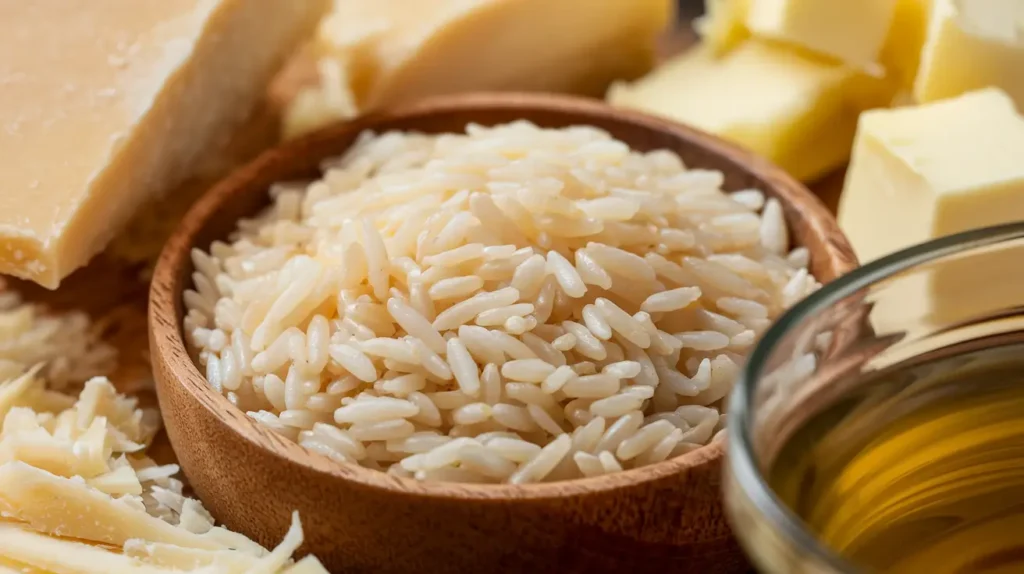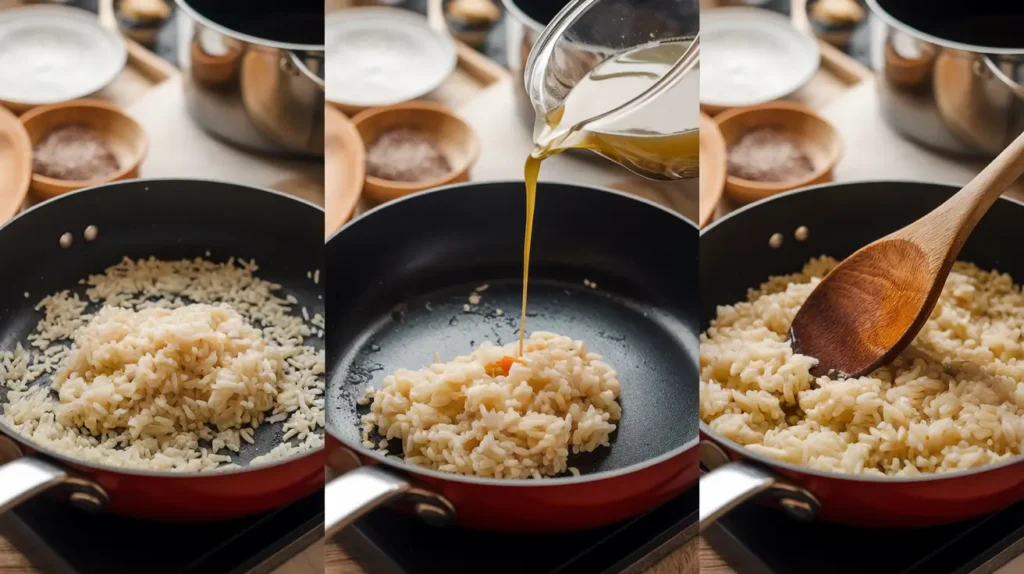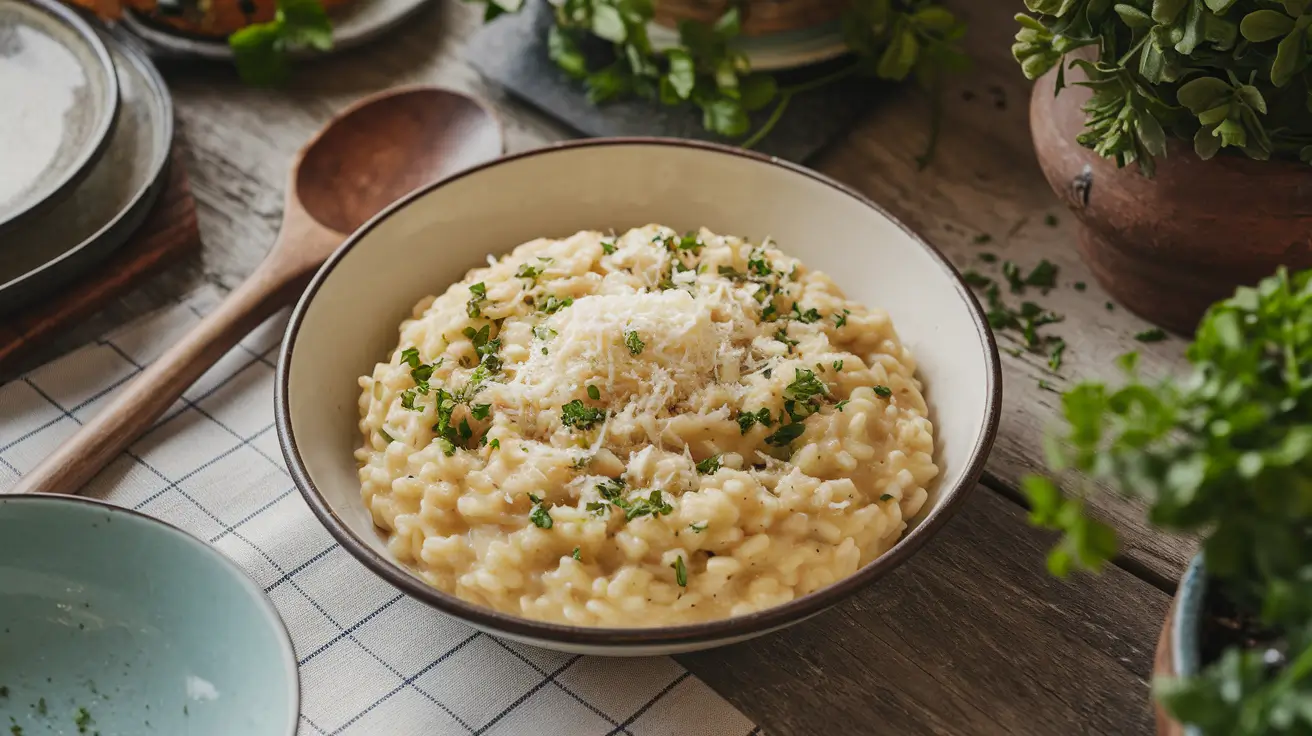Table of Contents
Is risotto a rice or pasta? That’s the million-dollar question that has puzzled food lovers worldwide! Risotto, the creamy, delicious dish that graces Italian dinner tables, often leaves people scratching their heads: What exactly is it? While its texture can remind you of pasta dishes, risotto is unique and entirely different. In this article, we’ll uncover the origins, ingredients, and science behind risotto to resolve this tasty dilemma.
We’ll explore why Arborio rice plays the star role, debunk misconceptions, and even walk you through how to make the perfect risotto. Along the way, you’ll learn fascinating facts, clear up common myths, and discover why risotto has nothing to do with pasta.
What is Risotto?
Understanding Risotto in Italian Cuisine
Risotto is a classic dish from Northern Italy, and it has made its mark worldwide. But what exactly is it? Simply put, risotto is a creamy, savory dish made primarily from short-grain rice varieties. Unlike pasta, which is made from wheat flour and water, risotto relies on rice’s unique ability to absorb liquid slowly, creating that signature creamy texture.
Definition of Risotto
Risotto is often defined as a rich, slow-cooked rice dish, where grains are gently simmered in broth while being stirred continuously. This constant stirring releases the starch inside the rice, transforming the dish into a luscious, velvety masterpiece.
Although risotto might look fancy (it’s even served in high-end restaurants), it’s surprisingly simple at its core—just rice, broth, and a few ingredients. So, where does the confusion come from? Keep reading as we explore why people mistakenly think of risotto as pasta.
Main Ingredients That Make Risotto Unique
You don’t need a long grocery list to make risotto. Its simplicity is part of its charm! Here are the essential ingredients:
- Arborio rice: This Italian short-grain rice is famous for its starch content and ability to absorb broth.
- Broth: The heart of risotto. Whether it’s vegetable or chicken-based, broth is added gradually.
- Butter: For richness and flavor.
- Parmesan cheese: Creates the final creamy finish.
- Fresh herbs: Parsley or basil is often sprinkled on top.
Unlike pasta, risotto does not rely on boiling water or pre-made noodles. Instead, it transforms humble rice into something magical through slow cooking and careful attention.
Why the Confusion Between Rice and Pasta?
Here’s the thing: Risotto often looks like a pasta dish because of its creamy texture. When served, it resembles something like macaroni and cheese or Alfredo pasta. But the comparison ends there.
- Rice: Risotto starts with uncooked rice that soaks up broth.
- Pasta: Traditional pasta is made from semolina flour, water, and sometimes eggs.
The constant stirring in risotto releases starches from the rice—not something pasta does. This starch gives risotto its luxurious consistency. So while pasta relies on sauces, risotto relies on the rice itself to shine.
Clarifying the Confusion: Rice vs. Pasta in Risotto
To make it crystal clear, here’s a quick breakdown:
| Feature | Risotto (Rice) | Pasta |
|---|---|---|
| Main Ingredient | Arborio rice or similar grains | Wheat flour and water |
| Cooking Method | Gradual liquid absorption | Boiled in water |
| Texture | Creamy, smooth | Firm or soft (al dente) |
| Key Factor | Starch release from rice grains | Sauces added for flavor |
In essence, risotto’s creaminess is not due to added cream but from the natural starches in the rice. Pasta, on the other hand, cannot achieve this effect on its own.
What is Risotto?

Understanding Risotto
Risotto, a beloved Italian dish, is a creamy and hearty meal that has captivated food lovers around the globe. Its origins trace back to Northern Italy, particularly the fertile Po Valley, where rice cultivation flourished. Unlike many other Italian dishes that revolve around pasta, risotto stands apart as a rice-based masterpiece.
This dish relies on slow cooking and constant attention to achieve its luxurious texture. But don’t be fooled—while risotto feels fancy on your plate, it’s surprisingly simple to make. By combining humble ingredients like rice, broth, and cheese, risotto transforms into an exquisite culinary experience that melts in your mouth.
Definition of Risotto
At its core, risotto is a slow-cooked rice dish where short-grain rice is gradually cooked by adding broth in small portions while stirring continuously. The starch released from the rice during this process is what creates its signature creamy consistency.
What makes risotto so versatile is its ability to adapt. It can be served as a main dish, a side, or even as an elegant appetizer. Despite its simplicity, risotto showcases the power of Italian cooking—turning basic ingredients into something extraordinary.
Main Ingredients of Risotto
The charm of risotto lies in its ingredients. While there are endless variations, a traditional risotto includes the following essentials:
- Arborio rice: The most popular short-grain rice used for risotto, known for its high starch content and ability to absorb liquid without breaking down.
- Broth: Slowly added in increments to cook the rice and develop flavor. Chicken, vegetable, or seafood broth are common choices.
- Butter: Adds richness and enhances the creaminess of the dish.
- Cheese: Parmesan cheese (Parmigiano-Reggiano) is often added at the end to bring depth and texture.
- Herbs: Fresh parsley or basil serves as a finishing touch to brighten the dish.
These simple components work together harmoniously. The slow cooking process allows the rice to absorb the broth while releasing starch, turning risotto into a dish that’s creamy, satisfying, and indulgent.
Why the Confusion Between Rice and Pasta?
So, why do people sometimes confuse risotto with pasta? At first glance, risotto’s smooth and creamy texture might resemble pasta dishes like Alfredo or macaroni and cheese. However, their similarities are purely surface-level.
The cooking process of risotto shares a key element with pasta—both rely on starch for texture. But here’s the difference:
- Rice: In risotto, the creamy consistency comes from the natural starch released as the grains are stirred and cooked gradually.
- Pasta: Pasta itself doesn’t release starch the same way. Instead, sauces are added for creaminess or flavor.
Furthermore, pasta is boiled and drained, while risotto involves cooking rice by slowly absorbing liquid. The constant stirring in risotto ensures that every grain of rice is perfectly coated and creamy, something pasta can’t achieve on its own.
In short, risotto may look like a pasta dish, but it’s very much a rice-based wonder that stands in a league of its own.
Is Risotto Made from Rice or Pasta?
The Role of Rice in Risotto
Risotto’s magic lies in the rice itself. Not all rice can deliver risotto’s signature creamy texture, which is why specific short-grain rice varieties are essential.
What Kind of Rice is Used in Risotto?
Risotto depends on short-grain, high-starch rice varieties that absorb liquid without turning mushy. The most popular types include:
- Arborio: Known for its high starch content, it creates that classic creamy consistency.
- Carnaroli: Preferred by chefs for its firm structure and ability to hold up during cooking.
- Vialone Nano: A smaller grain that cooks quickly but still results in incredible creaminess.
These types of rice stand out because they release starch while absorbing broth, unlike long-grain rice that stays separate when cooked.
Why Rice Makes Risotto Unique
The secret ingredient to risotto’s texture is the starch inside the rice. As the rice cooks, two types of starch work their magic:
- Amylopectin: The sticky starch that dissolves into the broth, creating risotto’s signature creaminess.
- Amylose: Ensures the grains hold their shape, giving risotto structure without falling apart.
Unlike pasta, which depends on sauces for flavor, risotto creates its own natural sauce as the starch is released during cooking.
Is Risotto Related to Pasta?
While both risotto and pasta are Italian staples, they couldn’t be more different.
Pasta’s Role in Italian Cuisine
Pasta is made from wheat flour and water, offering a chewy texture that pairs perfectly with sauces.
Key Differences Between Risotto Rice and Pasta
| Feature | Risotto (Rice) | Pasta |
|---|---|---|
| Base Ingredient | Short-grain rice | Wheat flour and water |
| Cooking Method | Slow absorption of broth | Boiled and drained in water |
| Starch Release | Naturally released while cooking | Minimal starch release |
| Texture | Creamy and cohesive | Firm, chewy, or soft |
Risotto’s creaminess is built from within the rice, while pasta relies on external sauces for richness. This key distinction makes risotto a uniquely satisfying dish.
The Science Behind Risotto
How Risotto Rice Creates Creaminess
The creamy texture of risotto isn’t the result of added cream—it’s all about the science behind the rice. Risotto rice varieties like Arborio, Carnaroli, and Vialone Nano are rich in two critical starches: amylopectin and amylose.
Role of Starch in Arborio Rice
- Amylopectin: The real MVP of risotto. This sticky, gelatinous starch is released as the rice cooks and is stirred. It dissolves into the broth, creating the dish’s signature creaminess.
- Amylose: Less sticky but equally important, amylose helps the grains maintain their structure, preventing risotto from turning mushy.
This balance of starch sets risotto rice apart. Unlike other rice types, such as long-grain rice, which stays fluffy and separate, short-grain rice delivers the velvety texture risotto is famous for.
How Rice Absorbs Liquid in Risotto
The step-by-step cooking process of risotto is what makes it so special:
- Toasting the Rice: The rice is sautéed lightly in butter or oil to coat the grains and prevent them from absorbing too much liquid too quickly.
- Gradual Broth Addition: Warm broth is added one ladle at a time. The rice absorbs the liquid slowly, ensuring even cooking.
- Constant Stirring: Stirring releases the amylopectin starch, which thickens the liquid and creates the creamy consistency.
- Final Creaminess: As the rice reaches al dente, the liquid transforms into a smooth, cohesive sauce without the need for cream.
This patient, controlled process is the secret to risotto’s luxurious texture.
Why Pasta Cannot Achieve Risotto Texture
Many wonder why pasta doesn’t deliver the same creaminess as risotto. The answer lies in the starch release and cooking methods.
- Pasta Starch Release: Pasta releases minimal starch during boiling. Most of it stays inside the noodles, and any released starch is drained away with the water.
- Risotto Starch Release: Risotto rice naturally releases a large amount of amylopectin into the surrounding broth, creating its own creamy sauce.
Pasta Cooking Process vs. Risotto Cooking
| Feature | Risotto | Pasta |
|---|---|---|
| Cooking Method | Gradual broth absorption | Boiled in water, then drained |
| Starch Usage | Retained and turned into creaminess | Lost in cooking water |
| Creamy Texture | Achieved naturally during cooking | Requires sauces or additives |
In short, risotto creates its own richness, while pasta depends on external sauces. This is why risotto offers a unique, velvety texture that pasta simply can’t replicate.
Origins and History of Risotto
Historical Background of Risotto
Risotto’s story begins in Northern Italy, particularly in the fertile Po Valley where rice farming thrived. Introduced to Italy in the 14th century, rice quickly became a staple in the region due to its ability to grow well in the wet, marshy conditions of Lombardy and Piedmont.
By the 16th century, rice was firmly established in Italian cuisine, and cooks began experimenting with slow-cooked rice dishes. This laid the foundation for what we now know as risotto.
One of the first and most famous risotto dishes, Risotto alla Milanese, originated in Milan. Made with saffron, butter, and Parmesan, it was celebrated for its golden hue and rich flavor—symbols of luxury and refinement during the Renaissance.
Risotto Through the Years
Over time, risotto evolved into a culinary icon. While the original Risotto alla Milanese remains a classic, risotto has embraced regional and modern variations:
- Classic Risottos: Recipes featuring mushrooms, seafood, and vegetables became staples across Italian kitchens. Simple yet elegant, these versions highlight local ingredients.
- Modern Variations: Today, chefs worldwide put their creative spin on risotto. Ingredients like truffle oil, butternut squash, and asparagus showcase its versatility. Even vegan and gluten-free adaptations have emerged, making risotto accessible to everyone.
Risotto’s journey—from the rice fields of Lombardy to tables across the globe—reflects its ability to combine tradition with innovation. Its creamy, comforting appeal remains timeless, proving that risotto is more than just food; it’s a culinary experience.
How Risotto is Cooked

Step-by-Step Guide to Cooking Risotto
Cooking risotto requires patience and precision. Here’s a quick guide to mastering this creamy dish:
- Sauté the Rice: Heat butter or olive oil in a pan, add chopped onions, and cook until soft. Stir in Arborio rice to toast it lightly.
- Gradually Add Broth: Pour warm broth in small portions, stirring constantly to let the rice absorb the liquid slowly.
- Stir for Creaminess: The key is continuous stirring. This releases starch from the rice, creating risotto’s signature creamy texture.
- Finish with Butter and Cheese: Once the rice is tender but firm (al dente), stir in butter and Parmesan cheese for a smooth, luxurious finish.
Why Proper Cooking Matters
Improper cooking ruins risotto’s texture:
- Too little stirring: Starch won’t release, leaving the dish dry.
- Overcooking: The rice turns mushy instead of creamy.
- Skipping broth additions: Adding too much liquid at once sacrifices the slow, creamy development.
A perfectly cooked risotto should be creamy and silky, with grains that are tender yet firm at the center.
Popular Misconceptions About Risotto
Myths About Risotto
Risotto is Not Just Fancy Rice
Risotto is much more than basic rice. Unlike plain boiled rice, risotto is a slow-cooked dish that relies on Arborio rice’s starch to create natural creaminess.
Is Risotto a Type of Pasta? (Debunking Myths)
While risotto’s texture might remind some of creamy pasta dishes, it is fundamentally different. Risotto comes from short-grain rice, while pasta is made of wheat flour and water.
Clarifying Common Misunderstandings
- Risotto = rice dish.
- Pasta relies on sauces; risotto creates its own creaminess naturally through starch release.
Nutritional Value of Risotto
Is Risotto Healthy?
Risotto can be a nutritious dish when prepared with balance. While it’s carb-heavy, the use of broth, vegetables, and lean proteins can make it a well-rounded meal.
Nutritional Breakdown
Here’s a general snapshot of 1 cup of classic risotto:
- Calories: 200–250 kcal
- Carbohydrates: 35–40 grams
- Protein: 5–7 grams
- Fats: 6–10 grams (mainly from butter and cheese)
Adding nutrient-rich ingredients like spinach, peas, or lean meats can boost its health benefits while keeping it flavorful.
Is Risotto Healthier Than Pasta?
It depends on preparation:
- Risotto: Naturally creamy due to rice starch, not heavy cream. Pairing it with vegetables or lean proteins makes it a wholesome option.
- Pasta: Often relies on calorie-dense sauces like Alfredo or carbonara, which can make it heavier.
When prepared mindfully, risotto can be healthier and more satisfying than traditional pasta dishes.
Risotto in Global Cuisine
How Risotto is Served Around the World
Risotto has transcended its Italian origins and taken on new forms worldwide:
- Italy: Traditional recipes like Risotto alla Milanese with saffron or mushroom risotto remain iconic.
- Spain: Inspired by paella, Spanish risottos often include seafood and bold spices.
- Japan: Japanese chefs use flavors like miso, soy sauce, and seaweed to create an umami-packed risotto.
- India: Indian-inspired risottos feature spices like cumin, turmeric, and coriander for a vibrant twist.
- United States: Chefs experiment with seasonal vegetables, truffle oil, and vegan variations, showcasing risotto’s versatility.
Is Risotto Popular Outside Italy?
Absolutely! Risotto has become a global favorite. Its creamy, adaptable nature makes it appealing across cultures and cuisines. Whether served in fine dining restaurants or cooked at home, risotto remains a dish that effortlessly combines comfort and sophistication.
Its growing popularity proves that risotto is more than just an Italian staple—it’s a culinary canvas that adapts to any flavor or ingredient.
FAQs – Is Risotto a Rice or Pasta?
What Makes Risotto Different from Pasta?
Risotto is made from short-grain rice that releases starch during cooking, creating a natural creaminess. Pasta, on the other hand, is made from wheat flour and relies on sauces for texture and flavor.
Can Risotto be Made with Pasta?
No, risotto cannot be replicated with pasta. Pasta lacks the ability to release starch gradually, which is essential for risotto’s creamy texture.
What is the Best Rice for Risotto?
The best rice types for risotto include Arborio, Carnaroli, and Vialone Nano, all of which are rich in starch and absorb liquid well.
Is Risotto Considered a Type of Rice Dish?
Yes, risotto is a rice-based dish that uses a slow cooking process to create its creamy consistency.
Does Risotto Taste Like Pasta?
No, risotto has a unique flavor and texture. Its creaminess comes from the rice itself, while pasta depends on sauces for richness.
Can Risotto be Gluten-Free?
Yes, risotto is naturally gluten-free as long as the ingredients, like broth and toppings, do not contain gluten.
Final Thoughts on “Is Risotto a Rice or Pasta?”
To wrap it up, risotto is undoubtedly a rice-based dish that stands apart from pasta in both preparation and texture. The magic of risotto lies in its starch-rich rice, which creates a creamy, luxurious consistency naturally—something pasta simply cannot achieve.
This timeless dish combines simplicity, elegance, and versatility, making it a true culinary masterpiece. So, the next time someone asks, “Is risotto a rice or pasta?” you can confidently say, “It’s rice—rich, creamy, and absolutely unique!”

Classic Creamy Risotto
Ingredients
- 1 ½ cups Arborio rice
- 4 cups chicken or vegetable broth kept warm
- ½ cup dry white wine
- 1 small onion finely chopped
- 2 tbsp unsalted butter
- 2 tbsp olive oil
- ½ cup Parmesan cheese grated
- 1 clove garlic minced
- Salt and pepper to taste
- 1 tbsp fresh parsley chopped (optional for garnish)
Instructions
- 1️⃣ Sauté the Aromatics:
- Heat 1 tbsp olive oil and 1 tbsp butter in a large pan over medium heat.
- Add chopped onion and garlic, cooking until soft (about 3-4 minutes).
- 2️⃣ Toast the Rice:
- Add Arborio rice to the pan, stirring continuously for 2 minutes until slightly translucent.
- 3️⃣ Deglaze with Wine:
- Pour in the white wine and stir until it’s mostly absorbed by the rice.
- 4️⃣ Gradually Add Broth:
- Add 1 cup of warm broth, stirring constantly.
- Once absorbed, add another cup, repeating the process until the rice is creamy and al dente (about 18-20 minutes).
- 5️⃣ Finish with Butter & Parmesan:
- Stir in the remaining butter and Parmesan cheese.
- Season with salt and pepper to taste.
- 6️⃣ Garnish & Serve:
- Sprinkle with fresh parsley (if using) and serve immediately.
Notes
Stir frequently but not constantly—this helps release starch while preventing it from becoming mushy.
Swap chicken broth for vegetable broth to make it vegetarian.
